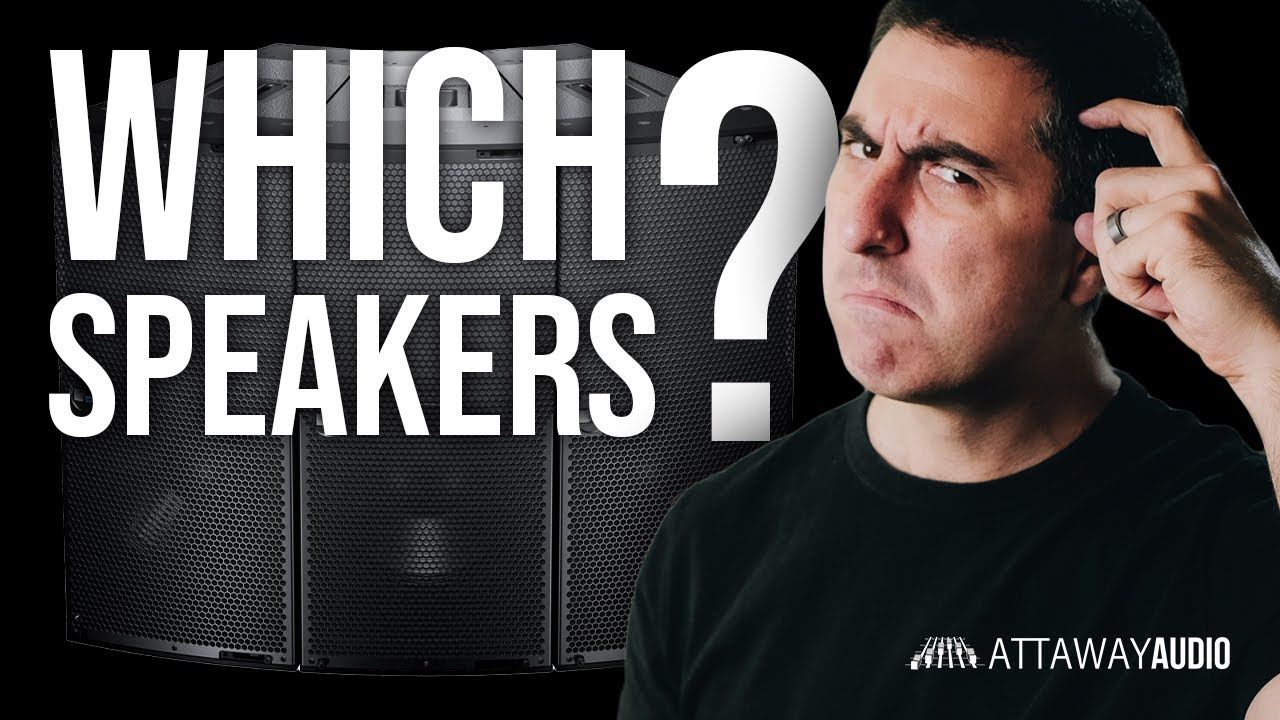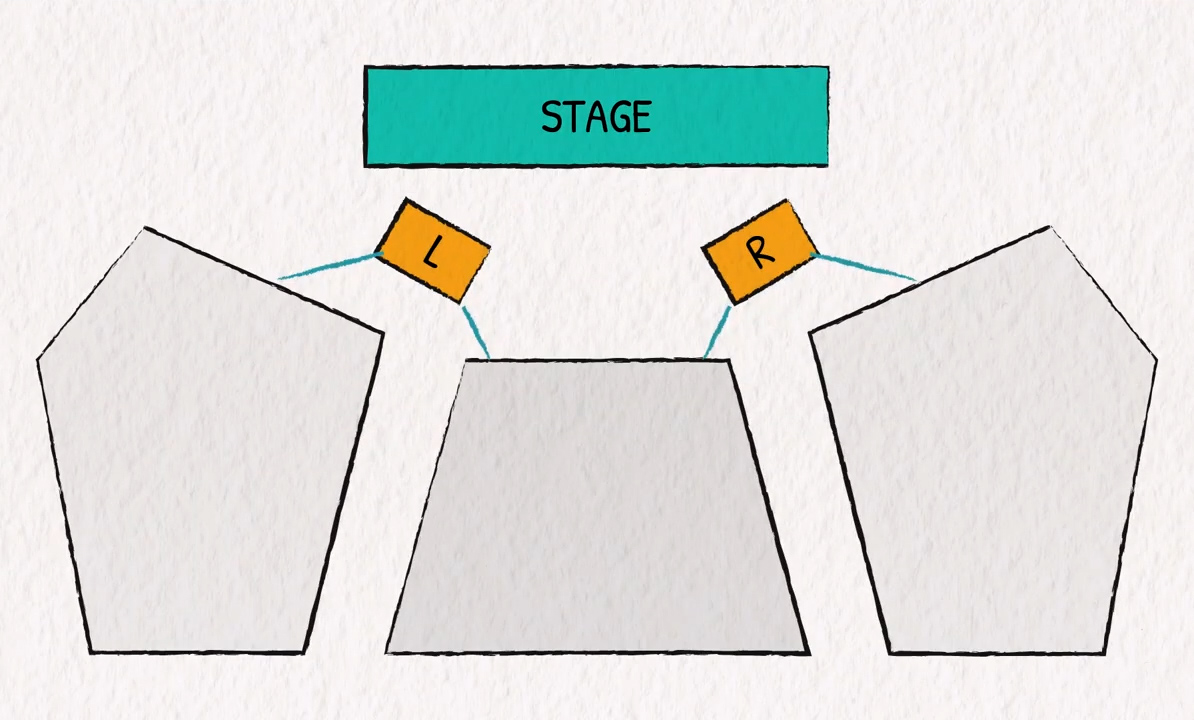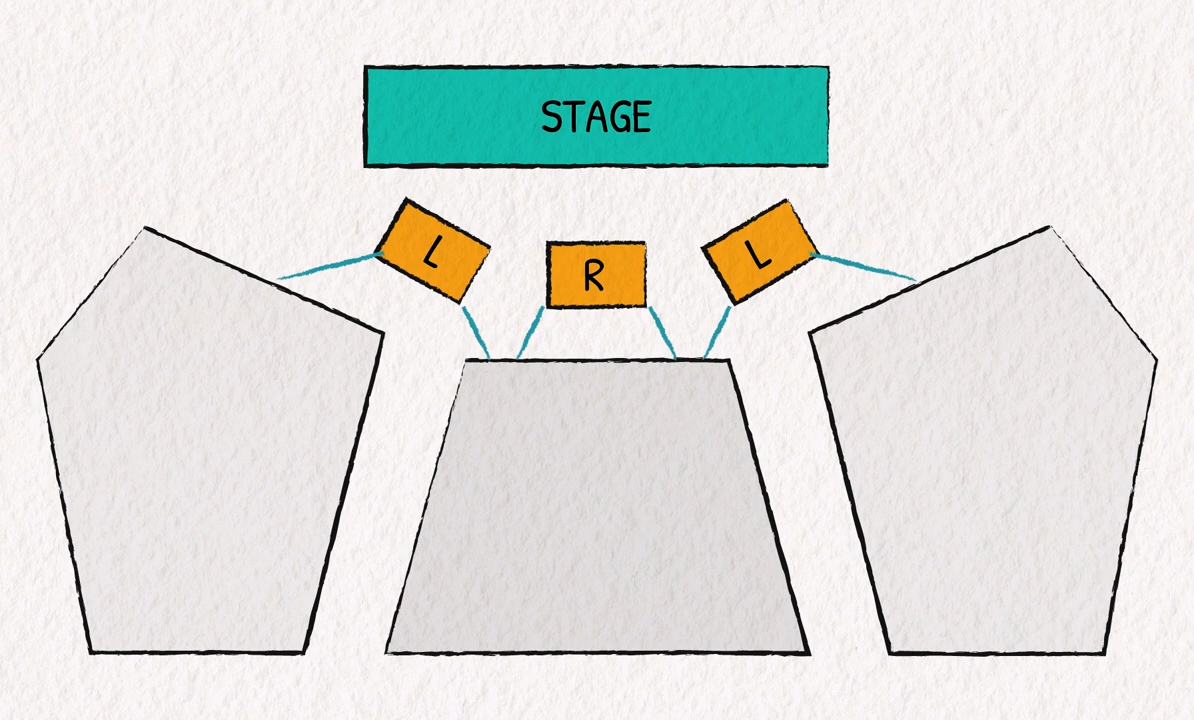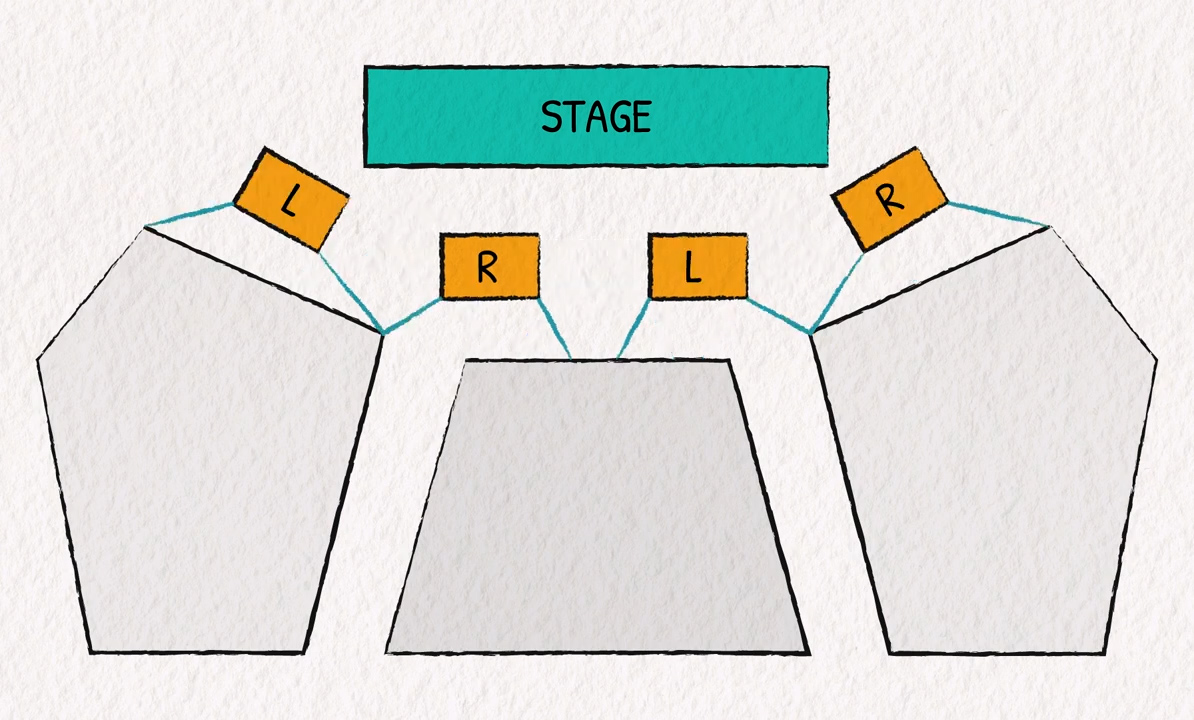How to Choose Live Sound Speakers

The speakers are the weakest link you have in your sound system at church. So how do you set them up the right way? And when you're picking new speakers, how do you arrange them? Today I'm going to walk you through some of the variables and some of the things you need to think about when you're talking to an integrator. Because for this, you really do need professional help.
Hey, if you're new here, my name is James, and I help church sound techs save the day by making the best audio decisions possible. If that's you, stick around and check out some of my other blog posts HERE!
Assessing Your Coverage Needs
The first thing you have to think about is matching the shape of the room and understanding the seating area that you need to cover. Is your seating more like an amphitheater with a fan shape? Do you have a long, narrow room? Do you have a wide, short room? These are all things that need to be taken into consideration before you start picking speakers.
Stereo Imaging - What Are Your Options?
Once you establish the shape of the seating area, you need to think about whether you're going to include a stereo image or not. You can pick it to be mono so that everybody in every seat gets the exact same signal, there are no two sides coming in for them. Or left, right, left if you've got a wider scenario. Or left, right, left, right or right, left, right, left, LCR, there are a whole lot of different options that you can choose to try to get some stereo imaging.





Let's take a field trip to a room where mono just makes the most sense.
Now, for a live sound environment, stereo imaging is going to look a lot different than the stereo imaging that you've got set up in, say, your home studio, or your high fi system, or listening in headphones. And while sometimes mono is the best option, whenever I can, I like to get a stereo system of some sort.
One of the big problems with stereo in live sound is that the left side doesn't always hear the right speaker and the right side doesn't always hear the left speaker. So why would you have separate outputs going to these if everybody's going to need pretty much everything anyway? Let's take a quick look at how our ears hear in stereo.
Our ear is combining the tone and timing differences from one ear to the other one to tell us direction. Basically “Is that coming from our left side or our right side or behind us or above us?” Our ear and our brain can decode all of these signals to give us a sense of direction, or space. So when something is louder coming from one direction than it is from another direction, our ear tells us, “Hey, that's coming from that side.”
When we hear something equally in both ears, that creates a phantom center channel. So when we're hearing something from the left and we're hearing something from the right, both of those arriving at the same intensity and the same tone gives us the idea that it's coming to us from straight in front of us. This works brilliantly for recordings, but in a live setting, we're not always seamlessly hearing the perfect balance of the left speaker and the right speaker. So what we tend to do is mix for a wide mono.
Some input sources have a stereo image to them. Even if they're not totally hard-panned left and right, there are some tones that are different on the left side than the right side. What this does in our mix is it opens up more room in the middle for the vocals. I mean, it's really all about hearing the vocals clearly, and they're the most important part of our mix. So having those right down the middle so that everybody can hear them on either side of the auditorium is most helpful. So our strategy for mixing isn't going to be like in the studio where we can pan something all the way to the left and all the way to the right, but it does still help to make more room for our vocals.
The other thing you have to think about is whether or not the speakers are going to overlap. Is the right side speaker going to overlap with the right side of the room? That's up to you. And that creates problems, and it solves problems. One thing you'll find out in live sound is that a lot of things are a compromise. You're not going to get sheer perfection like Mary Berry.
Live Mixing and Sound Reinforcement
You also have to remember that there is live mixing, where most of the sound is coming out of the P.A., and then there's sound reinforcement where we're just trying to amplify or reinforce the meaningful sounds that are coming off stage in the first place. Watch below to understand why some spaces work better with the mono/sound reinforcement model.
Point Source Vs. Line Array
Another thing you have to think about when matching the speakers to the room is whether or not you need a point source system or you need a line array. A point source system uses multiple boxes to point to different parts of the room, whereas a line array combines a bunch of boxes that tend to act like one big box, and they can be steered and have a lot better low frequency directionality.
Line arrays are typically seen on big tours where they have to cover a long area, but that doesn't necessarily mean that that's the best for your room in your church. A lot of times, one set of speakers isn't going to be able to cover the room sufficiently. So you have to think about other sets of speakers, like front fills, that sit on the front of the stage and fire at the first few rows, and delay speakers, which can fill in a gap either on the side or off to the back of the room where you might not be able to crank up enough energy from the front without pinning people's eyebrows back on the first few rows.
Acoustic Treatment - The Best Place to Put Your Money
Another thing you have to think about is putting the acoustic energy where you want it and not putting it where you don't want it. Reverberation from pointing the speakers at the walls can cause intelligibility issues. So people will say, “I can't understand”, but it isn't because they're lacking energy, it's because they're getting confusing signals from getting a bounce off-the-wall and hearing the direct sound as well. That's why I never hesitate to recommend acoustic treatment for a room. If your sound system is a race car, the acoustic treatment and the design of the room is the race track. You're only going to go so fast with an F1 racer going down a dirt road in the backwoods of Missouri. Acoustic treatment is also an audio upgrade that lasts through a lot of iterations of sound equipment. So if you've got sticker shock about what it's going to take to treat your room acoustically, don't fret. This is going to be a long-term investment and it's worth the money.
Ensuring Your System Has Enough Headroom
The next thing you need to think about when you're choosing your speakers is how loud they need to be. If you know how much energy you need from your sound system, you can get the right amount of amplifier to push those speakers. Take your average max dB SPL and then add 10 dB and that should be enough headroom so that when things do need to get loud, you're not going to distort the speakers. Some churches I mix at like to live around 90 to 92 dB SPL A-weighted, and sometimes it can get louder than that. So you'd need to set your max headroom for that sound system around 105, maybe 110 dB SPL. It's not that you're going to live there, but you want to have that headroom so that you don't distort your amplifiers. Another church where I've done training, they've got a target at about 82 dB SPL, they really don't need it that loud. So you don't need to pay for the horsepower of the amps that are going to go to 110 dB at a church that is really never going to get above 95.
Another reason why you want a lot of headroom in your system is that if the amplifiers distort, that's hard on the speaker components because they're not swinging freely back and forth. They're starting and stopping very suddenly at the end of their excursion. And damaged components don't sound good at any level, so try to avoid that and give yourself lots of headroom.
How Much Bandwidth Do You Need?
The next thing you need to think about with which speaker system you're choosing is how much bandwidth you need. Basically how many low frequencies you have. And you probably need all the high frequencies. But if you're just doing the bare minimum, speech intelligibility happens between 300Hz and 3K. That's basically all that an old telephone will transmit. If you're just doing speech and acapella singing, you're going to want a little bit more than that, but you don't need to go all the way down to 100Hz. Unless the Gaither family is coming in. They're really reaching for those low notes and they want everybody to feel it.
If you have pianos, organs, and other acoustic instruments, your sound system might need to reach down to about 100Hz, maybe 80. But if you have bass and drums, you're going to need some subwoofers, and they're going to have to reach at least down to 40Hz. Now, before your keyboard starts smoking with the angry comments that you're ready to type to me, just hang on, these are generalities.
Speaker Mounting - Choosing the Option that Best Serves Your Church
Now, you can't just buy the speakers, you actually have to put them somewhere. How are you going to put them where they need to go? You can stack them on the ground and that's easy enough. But that's not going to get up over the heads of the people in the front row to get to the people in the back row. So I recommend speaker stands. Speaker stands are great because they're easy to move, you can mount them quickly, and if you're in a mobile church situation, that might be your only option. Now, the benefit of the speaker's stands is that they're easy to adjust, right? You can get to the speakers themselves, you just crank it back down and there you go, you're back down on the ground. But speaker stands are limited in that it's hard to get them high enough and unless you get a really expensive stand. And then you've got a really big stand on the front of your stage, and that can obstruct sightlines. It's another thing we have to consider. People aren't just there to hear stuff, although as audio people, we like to imagine that. People actually need to see things too. So if you're taking up too much room on your stage, that can block certain parts of the room from being able to see on stage.
Your next option, which is best for installs, is to hang them from the ceiling. And rule number one is don't kill anybody. You really, really need to be licensed or know what you're doing in order to rig something from the ceiling. I don't want anybody to die because they read this blog post and I told you that hanging the speakers was a better option because you didn't follow the right safety protocols to keep them from crushing somebody.
The pros of hanging them is that you can get them up and out of the way, you don't need a stand that's blocking sightlines, and you can usually get them right where you want them. The cons are that once they're up there, they're a little bit harder to adjust without getting a lift or scaffolding. And that can be a real pain.
At my church, in this season, we've got a saying, “Function over Fung Shui”. We don't really care how good it looks as long as it works. But there are other seasons, or other churches, where the visual importance of how the speakers look plays a bigger role. So just know what's important to you before you suggest a giant line array hanging in the middle of your cathedral. That might not go over so well with some people.
Prediction Software - Another Tool in Your Sound Toolbelt
Another thing you can do before you buy speakers and hang them in your room and then decide that you don't like them is to use prediction software. This can model your room, the speaker, and how its output is going to perform across different frequencies, taking into account the different angles and how they're going to resonate with the room.
Video transcription: "So here is a demonstration of Display 3 from Martin Audio. And you can see here we've got a theater. I've already calculated the SPL with just these speakers. I've got these two muted you can see down here. And so I'm going to calculate the SPL and you can see there's a little bit of drop off over here. So I created a couple little front fill speakers and I've got them turned down 9 dB, let's unmute them then we can hit calculate SPL, and you can see that there's a little more coverage over here, but you can tell there's some comb filtering over here because it's lighter as well.
So there's some issues there, we could play around with the timing and milliseconds to get those delayed if we wanted to try to fix them. But that's just a quick example of what you can do with that. You can load in different sketch-up devices or scenes so that you can model your own sanctuary and figure out how to use that."
Some of them you can check out are QSC, JBL, Martin, and Meyer. And I'm not that well versed in it or I'd show you all about it. And while these can be super helpful, they're not going to be perfect representations because they don't take into effect every single parameter about your wall density, acoustic treatment, lots of different things. So take it with a grain of salt when you design the perfect speaker system and then it doesn't perform exactly how you thought it was when you get it hung.
High Quality Speakers - Are They Worth the Investment?
Now, if you're shopping for new speakers, you might have gotten sticker shock. They can be really expensive. But what separates a high quality, high price speaker from a low quality speaker? The answer to that question has a lot of nuance to it.
You can get higher quality components that are going to last longer and maintain their level of quality over a longer period of time. I mean, we are talking about electronic and mechanical components that do wear and tear. So the better that they're built, the longer they're going to last. And I'm a big fan of buy once cry once. It really does hurt on the front end when you buy a better speaker. But if you only have to buy it once, that ends up being cheaper over the long run.
Besides durability and maintaining those high standards, you also get more consistency. Some speakers are more precise in their directionality or they're only going to put the energy in one area at a time. So if you've got a highly reverberant room and putting up acoustic treatment isn't possible, the speakers can keep that energy focused on the listening area and not on the walls, bouncing around and creating more problems.
Another thing that your executive pastor probably isn't thinking about is the way that the crossovers behave and in those frequency regions where both speaker components are operating at the same time. That could be another place where things can get funky, that can mess with intelligibility, and a higher quality speaker is going to have better components feeding that.
There are a few other things that go into high quality speakers that you can't put your finger on until you actually hear it in person. You're not going to be able to read these in a spec sheet or in a review online. And that's the punchiness and the smoothness of the top end. The punchiness is how quickly it can move low frequencies. And this is a feeling thing that you're just going to have to compare one speaker to another to know what I'm talking about. The smoothness on the top end makes it so that it doesn't get harsh when it gets loud. Or if it's got better components to it, it’s going to smoothly recreate those higher frequencies even at high SPLs. So when it gets louder, it doesn't necessarily get harsher. And that's one of the things where people say, “Oh, I don't like it this loud”, but they would be able to tolerate it louder if it just sounded better.
Now, the last thing I'll talk about when we're talking about quality is the detail. This is something that's hard to put your finger on. But when a speaker can recreate sounds at a low level with a lot of accuracy, and it's got a low noise floor, you feel like there are these interchangeable feelings that are right up in your face, or you can hear all these details. I don't know how else to describe it other than it's like somebody took a blanket off a speaker and suddenly it feels a whole lot more real. When a speaker has a lot more detail and a lower noise floor, you can get a lot more dynamic range out of the speakers. You can make the quiet parts much quieter, but they're still easy to understand.
Lessons From The Real World
If you'll bear with me, let me tell you a story about this. At the International House of Prayer in Kansas City, they run 24/7 with prayer and worship teams cycling around the clock. So there's somebody mixing audio for a worship team all the time, and they've been going for 22 years. In our global prayer room, we had some Meyer speakers (and I forgot the model number, but it's a bunch of letters in a number). They had been running for well over ten years and they still sounded great. But then a few years ago I got to mix one session at our One Thing conference, which was down at Bartle Hall, where there were around 20,000 people. They had a brand new JBL line array, and suddenly I knew, “Oh, these are the same worship teams, but I hear a whole lot more detail than I do on those other speakers.” I went back to the prayer room, same worship team, same inputs, the console difference is negligible, but I thought, “We are missing so many details.” Fast forward a couple of years and we get that same line array in the prayer room, and all the details are back. Suddenly we could all mix quieter because it was easier to understand things at a lower level. So the quality of the speakers isn't just how good they sound when they get loud. And I love that part too. But also how nice they sound when they're quiet, and how much detail and emotion you can get out of it. Now I'm talking feelings again, but y'all, it's real. I love great speakers that bring out those details because it allows you to craft a more emotional mix, and it's just more enjoyable.
Hiring an Integrator - A Worthwhile Expense
Now when it comes to getting a new sound system, I always recommend getting an integrator because they're doing this every day. They're staying up to date with all the latest manufacturers releases and new products, they've seen a bunch of different rooms, seeing how well things have worked. Plus they've got experience with rigging, or at least knowing who to hire to do the rigging so that nobody dies at church. Plus, once the speakers are in, it's just as important to get them set up just right with getting the precise angle they need, with getting the system EQed, and the delays and the crossover set up just right. Having experience in this goes a long way, so please do yourself a favor: do it right the first time and hire an integrator.
And I hesitate to say this, but also know when to fire an integrator. If you're not happy with the results that you got, even if you were happy with the process or you thought that you were getting what you wanted and then music doesn't sound good, don't be afraid to call in somebody else to try and get you what feels good. It doesn't matter how it looks on paper or how it looks on a graph on the computer. It's got to feel good in-person. So if you have to redo it, that stinks. But redo it. Because you're going to be stuck with those speakers for a long time and it's worth it to rearrange everything so that it's easy to mix. Because remember, the speakers are the weakest link in your sound system. Things are going to get a whole lot easier for everybody, including brand new volunteers, if what you hear is what you get.
Environment Plays a Role
A parting nerdy note is that room tuning is going to change with seasonality and humidity. Because frequency is dependent on air velocity and air velocity changes with temperature and humidity. The frequencies that worked for notching out in your room's acoustics one day might not work the same the next day if the temperature has shifted by 40 degrees like it does here in Kansas City. So go ahead and delete the phrase “That's the way we've always done it.” from your vocabulary and do what it takes to make it work right.
Do it Right the First Time
So in conclusion, the speakers are the weakest link in your sound system, and they're the hardest to change. So do it right. Do it right the first time. Go for buy once, cry once and I promise you'll thank me later. Don't forget to listen to music and make great judgments with your ears. That nagging thing that's bugging you? Don’t ignore it. Try to find the source and fix it. Every single person that visits your church service, unless they're deaf, is going to be affected by the speakers. (And even if they are deaf, the subs are still going to affect them.) Your goal is to get the speaker system consistent for every single seat in that church so that everyone can have an enjoyable experience of the worship time and hear the message without thinking about the sound system. That's why you're there - to think about the sound system so everybody else doesn't have to.
Remember: it’s all about the low end, avoid the sound tech solo, and nobody leaves church humming the kick drum. We'll see you back here next time on Attaway Audio.
Lead your sound team with clarity!
Sign up for your FREE guide - How to Lead Your Church Sound Team. Clarify the vision for your team, build your team, and create a clear path toward making every worship mix enjoyable.
We hate SPAM. We will never sell your information, for any reason.

